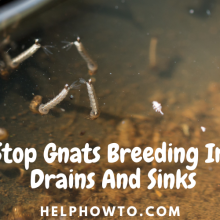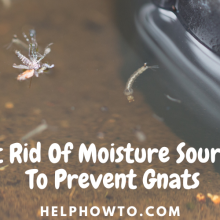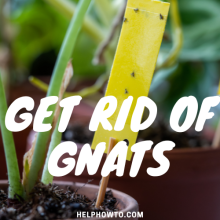Do Gnats Come From Standing Water? | HelpHowTo
Summary of Answering Do Gnats Come From Standing Water
Gnat infestations are incredibly frustrating, with these tiny flies swarming faces and potentially transmitting diseases like conjunctivitis or Zika virus. The key to controlling gnats is eliminating their breeding grounds in standing water sources. Female gnats lay eggs in stagnant water like clogged gutters, birdbaths, or plant trays. The eggs hatch into larvae that feed on organic matter in the water before pupating into winged adults that live about a week. This cycle can repeat in just 4-5 days, allowing rapid population growth.
To stop gnats, regularly inspect indoors and out for any standing water sources, and drain, treat with larvicides, or remove them. Fix leaks, use dehumidifiers, remove decaying organic matter, and seal cracks. Biological controls like mosquito fish can help with heavy infestations. Vigilant water source removal through routine inspections is crucial for effective gnat prevention and avoiding health risks from uncontrolled populations.

Our Top 5 Recommended Indoor Genat Traps
Sick of pesky gnats invading your home? Discover the top 5 indoor gnat traps to banish these annoying insects for good! Our expert reviews reveal the most effective, easy-to-use traps. From powerful UV attractants to eco-friendly vinegar traps, we’ve thoroughly tested and ranked the best solutions. Check Now

Gnat Infestations: How to Stop Them from Breeding in Standing Water
Few things are more frustrating than a gnat infestation. These tiny flying insects have an incredibly annoying habit of swarming around faces, getting in eyes and ears, and making any outdoor activity miserable. Beyond just being a nuisance, large gnat populations can also potentially transmit diseases and bacteria. The key to controlling gnats lies in understanding where they breed and how to eliminate their prime breeding grounds – sources of standing water.
Where Do Gnats Come From?
Gnats rely on standing water to reproduce and their entire lifecycle is centered around these moist environments. Adult female gnats lay their eggs in any source of stagnant water they can find, such as clogged gutters, birdbaths, potted plant trays, or even something as small as a upturned frisbee collecting rainwater. Hundreds of eggs can be deposited by a single female gnat.
After the eggs hatch within a day or two, the gnat larvae emerge and continue their development in the standing water. The larvae feed on any organic matter like algae, bacteria, or decaying leaves present in the water source. Depending on the gnat species and temperature, the larvae may remain in the water for 4-10 days before entering the pupal stage.
It’s during this pupation period that the insect transitions into its adult winged form. Once mature adult gnats emerge from the pupae, they only live for about a week but the females get right to work mating and restarting the reproduction cycle by laying more eggs. This is why gnat infestations can escalate so rapidly – the time from egg to adult can be as little as 4-5 days under ideal conditions.
Identifying Gnat Breeding Spots
To control gnats, you first need to locate all the areas where these pests may be breeding. Inspect both indoors and outdoors for any sources of standing water, no matter how small. Outdoors, check gutters, birdbaths, flowerpot trays, kiddie pools, pet water bowls, and any low areas where water collects after rain. Don’t overlook smaller items like upturned frisbees, buckets, or toys that could be harboring eggs or larvae.
Indoors, bathrooms and kitchens are prime gnat breeding zones. Inspect sink areas, floor drains, shower stalls, and potted plant trays for any standing water. Different gnat species also have preferences – fungus gnats thrive in excess moisture in potting soil while drain gnats breed in sewers and septic systems. If you see swarms of tiny flies in a particular room, that’s a good indicator there is likely a nearby water source breeding them.
Eliminating Gnat Breeding Grounds
Once you identify all the potential gnat breeding spots, it’s time to take action and eliminate them. Here are the most effective methods:
- Drain all sources of standing water regularly, both indoors and out. Tip over any containers, empty plant saucers and birdbaths, and clean out clogged gutters and drains.
- Fix any leaks that may allow water to pool or moisten areas. Use fans, dehumidifiers, and proper ventilation to thoroughly dry up damp spaces.
- Remove any decaying organic matter like leaves, grass clippings, or spilled drinks that gnats may be feeding on.
- Treat any remaining standing water that cannot be drained with a larvicide or insecticidal oil to disrupt the gnat breeding cycle.
- For serious infestations, use biological controls like mosquito fish that feed on gnat larvae or parasitic nematodes that attack the larvae.
- Seal up any cracks or crevices that may allow gnats entry into your home or allow them refuge.
The Downside of Failed Gnat Control
Letting gnat populations go unchecked is more than an inconvenience – it can pose legitimate health risks. While most gnat species do not bite humans, some like eye gnats can be vectors for serious bacterial infections like conjunctivitis. There are also some reports linking certain gnats to the potential transmission of illnesses like Zika virus.
Even if disease transmission is not an issue, large gnat swarms can severely reduce quality of life simply by making it difficult to spend time outdoors or open windows without being inundated by the pests. Allowing gnat reproduction to continue unabated will only lead to larger and harder to control infestations.
Prevention is Key
The best way to manage gnats is through vigilant prevention and early treatment of any breeding sources. Perform routine inspections for any areas of standing water buildup, and immediately drain, treat, or remove those sites. Install screens and seal cracks to keep gnats out, and consider using pheromone traps to monitor for any resurgence of gnat activity.
By understanding gnats’ dependence on moisture for reproduction and taking steps to eliminate those aquatic breeding grounds, homeowners can effectively get gnat populations under control. Letting infestations escalate is not only a nuisance, but a potential health risk. With some diligence in removing standing water sources, gnats can be kept at bay.

Our Top 5 Recommended Indoor Genat Traps
Sick of pesky gnats invading your home? Discover the top 5 indoor gnat traps to banish these annoying insects for good! Our expert reviews reveal the most effective, easy-to-use traps. From powerful UV attractants to eco-friendly vinegar traps, we’ve thoroughly tested and ranked the best solutions. Check Now
FAQs and Answers
How long can gnat eggs survive in standing water before hatching?
Gnat eggs can typically survive in standing water for 2-3 days before hatching into larvae.
The exact hatching time depends on the species of gnat and the water temperature, but most gnat species’ eggs will hatch within 48-72 hours after being laid if the right moisture conditions are present.
Some key points about gnat egg survival in standing water:
- Warmer water temperatures (70-80°F) facilitate faster hatching, often within 1-2 days.
- Cooler water (below 60°F) can delay hatching up to 4-5 days.
- Eggs require water to develop and will desiccate and fail to hatch if the water source dries up before they hatch.
- Fresh eggs laid by newly emerged female gnats tend to hatch quicker than older eggs.
So while gnat eggs don’t necessarily need to be eliminated within just a day or two, treating or draining standing water sources every 3-4 days is advisable to disrupt their breeding cycle before the eggs develop into larvae.
Are some types of standing water more attractive to gnats than others?
Yes, certain types of standing water are generally more attractive to gnats for laying their eggs compared to others. The key factors that make a water source appealing for gnat breeding include:
Stagnant Water
Gnats prefer standing water that is stagnant and stale rather than flowing or frequently disturbed sources. The lack of movement allows eggs and larvae to develop undisturbed.
Organic Matter
Water sources containing decaying organic matter like plant debris, animal waste, or fungi are very attractive to gnats. The larvae feed on this organic material.
Water Quality
Gnats are usually drawn to nutrient-rich, polluted or contaminated water over very clean water sources. The impurities provide food sources.
Shaded Areas
Standing water in shaded areas that don’t receive direct sunlight tends to be more appealing for gnats to breed versus very sunny areas.
Some examples of prime gnat breeding spots include:
- Clogged rain gutters
- Trash cans/dumpsters collecting rainwater
- Bird baths or plant saucers with stagnant water
- Sewage areas or septic tanks
- Tree holes collecting water and rotting leaves
Cleaner sources like pools or freshwater areas flushed by rainfall don’t tend to produce as many gnat infestations unless seriously neglected. Providing drainage and removing stagnant nutrient sources is key.
What is the effective treatment radius for larvicides and oils used to control gnat larvae?
The effective treatment radius for larvicides and oils used to control gnat larvae can vary, but typically covers the following areas:
For Larvicides:
- Most liquid larvicide products effectively treat around 25-50 square feet of standing water per application.
- Granular/pellet larvicides can cover 100-200 square feet per application when properly dispersed.
- The treatment radius is impacted by factors like water depth, vegetation, and organic matter levels.
- Larvicides may need to be reapplied every 7-14 days for continual control as their potency diminishes over time.
For Oils/Insecticidal Oils:
- A thin coating of oil can effectively smother gnat larvae over 20-30 square feet of standing water.
- Proper application achieving complete surface coverage is important for efficacy.
- Oils need to be reapplied after any disturbance to the water source and after heavy rains.
- Some oils may require higher application rates in water with high organic content.
A few additional considerations:
- Wind can impact the effective treatment radius by dispersing larvicides/oils unevenly.
- Smaller, contained water sources like planters may only require spot treatments covering a few square feet.
- Larger pools or ponds may need multiple treatment points spaced appropriately to cover the full area.
Closely following product label instructions is recommended, as treatment radiuses can vary between specific larvicide and oil formulations based on their concentration and chemistry. Precise coverage is key for successful gnat larvae control.
How far can adult gnats travel from their original breeding site?
Adult gnats generally do not travel very far from their original breeding site or source of standing water where they emerged. Their dispersal range is typically quite limited compared to some other flying insect pests. Here are some insights on how far gnats may spread:
- Most gnat species only travel around 100-300 feet away from their larval habitat on average when conditions are favorable.
- In drier conditions or when there is a lack of new breeding sites nearby, gnats may disperse up to 500-600 feet in search of new moisture sources.
- Wind can aid in gnats being blown further distances, but they don’t intentionally travel more than about 1000 feet from their place of emergence even in windy conditions.
- Fungus gnats and other gnats that develop indoors often remain inside and will not venture outdoors unless there is easy access through doors/windows.
- Adult gnats congregate and swarm in proximity to their aquatic breeding sites, so heavy infestations are typically centered around the source.
- Females may spread a bit further afield than males when seeking out new areas to lay eggs in standing water.
The short lifespan of most gnat species of 7-10 days for adults limits how far away they are able to travel and establish new breeding colonies during that time period. Controlling gnats really comes down to locating and eliminating their aquatic larval habitats within a few hundred feet of where the biting adults are present.
Do certain environmental conditions accelerate or slow gnat reproduction cycles?
Yes, certain environmental conditions can significantly impact how quickly or slowly gnats are able to complete their reproduction cycles and life cycles. The major factors that influence gnat breeding rates include:
Temperature:
- Warmer temperatures accelerate gnat development – At 80°F, some species can go from egg to adult in as little as 4 days.
- Cooler temps below 60°F can slow development down to 2-3 weeks.
- Ideal temps around 70-80°F facilitate the fastest reproductive cycles.
Moisture Levels:
- Consistent moisture and standing water availability allow continuous egg-laying and larvae survival.
- Drier conditions with irregular rainfall limit breeding opportunities.
- High humidity can aid adult gnat longevity and egg production.
Organic Matter:
- Presence of decaying organic matter in breeding sites provides abundant food for larvae, speeding growth.
- Lack of nutrient inputs can stunt larval development.
Overcrowding:
- When gnat populations get too dense, competition for resources can slow development rates.
- Undisturbed, spacious breeding sites enable maximally fast reproduction cycles.
In general, warm and wet conditions with ample standing water and organic matter create the perfect environment for accelerated gnat life cycles and rapid population growth. Cooler, drier periods with fewer nutrient inputs tend to suppress and delay reproduction rates.
Understanding these environmental influences can guide timing for inspection and treatment of potential gnat breeding sites before populations can escalate during their prime temperature/moisture windows.

Our Top 5 Recommended Indoor Genat Traps
Sick of pesky gnats invading your home? Discover the top 5 indoor gnat traps to banish these annoying insects for good! Our expert reviews reveal the most effective, easy-to-use traps. From powerful UV attractants to eco-friendly vinegar traps, we’ve thoroughly tested and ranked the best solutions. Check Now




